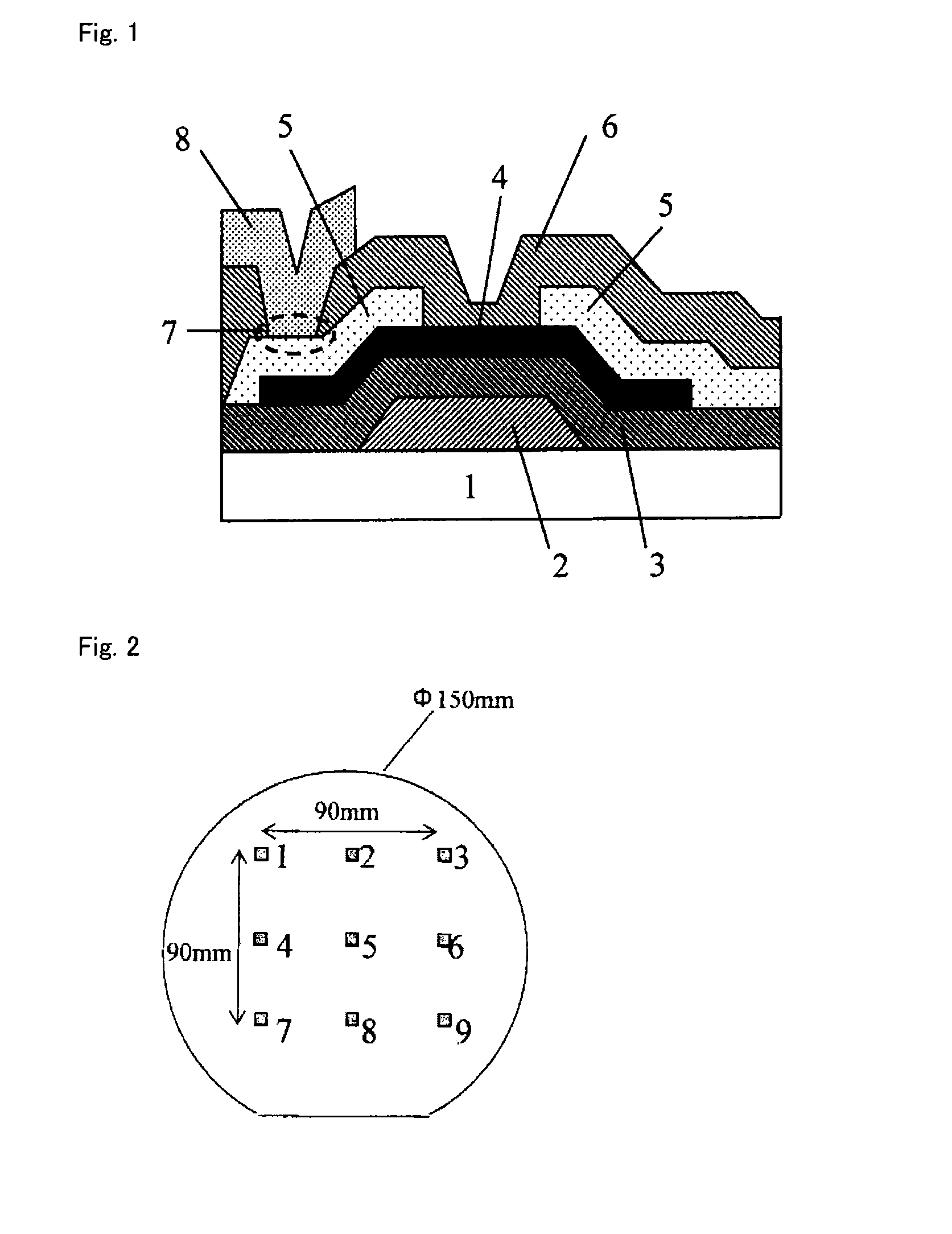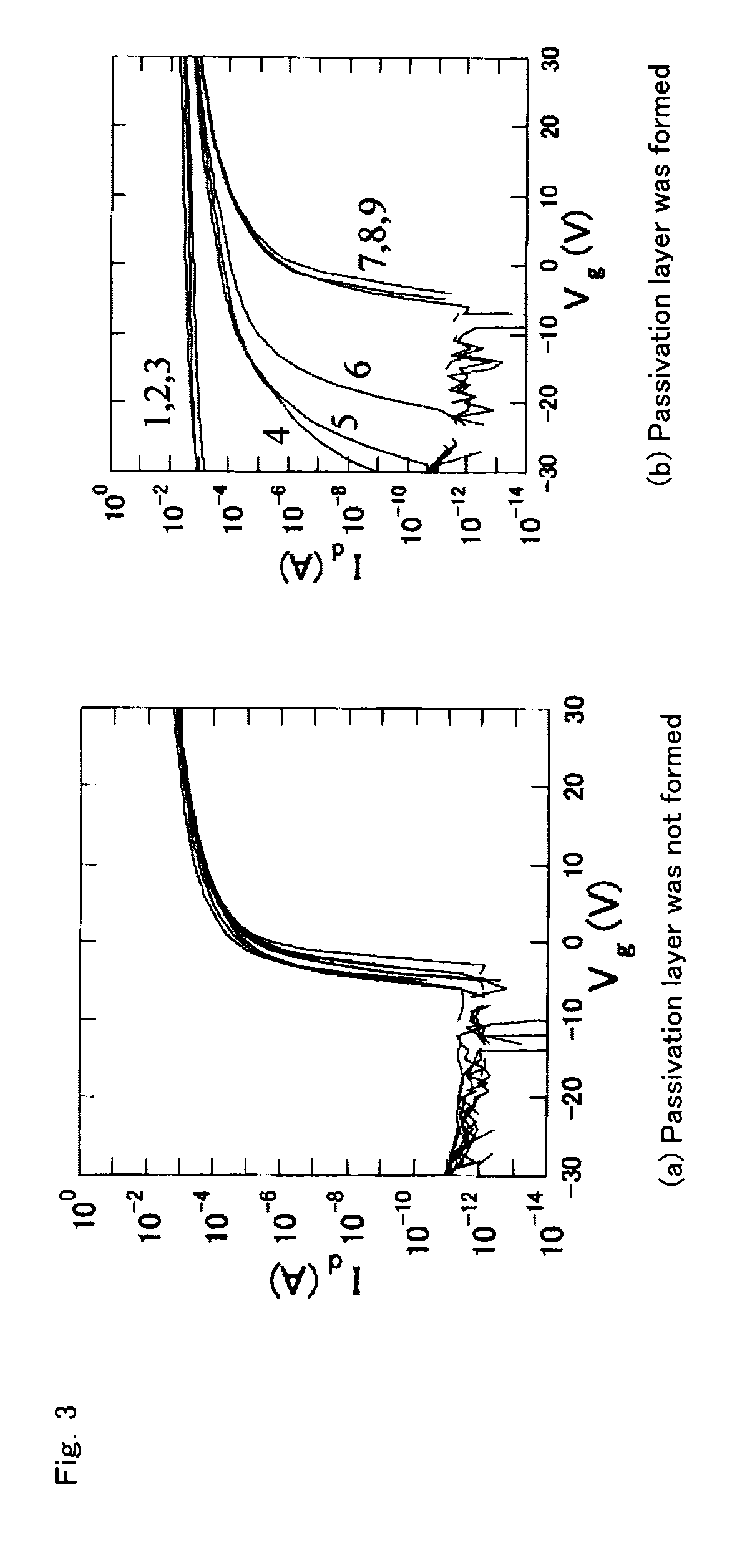Oxide for semiconductor layer of thin-film transistor, sputtering target, and thin-film transistor
a technology of sputtering target and thin-film transistor, which is applied in the direction of oxide conductors, non-metal conductors, conductors, etc., can solve the problems of oxygen defects, desorption of oxygen contained in the oxide semiconductor, and increase in material cost in mass production processes, so as to achieve excellent switching characteristics, prevent tft characteristics from being deteriorated, and obtain favorable characteristics stably
- Summary
- Abstract
- Description
- Claims
- Application Information
AI Technical Summary
Benefits of technology
Problems solved by technology
Method used
Image
Examples
example 1
[0062]According to a method as described above, a thin-film transistor (TFT) shown in FIG. 1 was produced, and TFT characteristics before and after the formation of a passivation layer were evaluated.
[0063]First, a Ti thin film having a thickness of 100 nm as a gate electrode and a gate insulator layer of SiO2 (having a thickness of 200 nm) were successively formed on a glass substrate (“EAGLE 2000” available from Corning Incorporated, having a diameter 100 mm and a thickness of 0.7 mm). The gate electrode was formed using a pure Ti sputtering target by a DC sputtering method under the conditions: film formation temperature, room temperature; film formation power, 300 W; carrier gas, Ar; and gas pressure, 2 mTorr. Further, the gate insulator layer was formed by a plasma CVD method under the conditions: carrier gas, a mixed gas of SiH4 and N2O; film formation power, 100 W; and film formation temperature, 300° C.
[0064]Then, oxide thin films having various compositions as shown in Tabl...
example 2
[0115]In this Example, oxide films (having a thickness of 100 nm) were measured for density, which oxide films had been obtained using the oxide with a composition corresponding to No. 4 in Table 1 (i.e., Zn—Sn-5 at % Si—O, [Zn]:[Sn]=6:4, Zn ratio=[Zn] / ([Zn]+[Sn])=0.6, Si ratio=[Si] / ([Zn]+[Sn]+[Si])=0.05) and controlling pass pressure during the sputtering film formation to 1 mTorr or 5 mTorr. Further, with respect to TFTs produced in the same manner as described above in Example 1, carrier mobility (or field-effect mobility) was calculated using the expression described below. In this Example, those in which saturated mobility thus determined was 5 cm2 / Vs or higher were considered as passing. Further, the amount of threshold voltage change (ΔVth) after the stress test (light illumination plus negative bias application) was examined. Their measurement methods are as follows:
[0116]Id=12μFECOXWL(Vgs-Vth)2[MathematicalExpression2]
where Cox is the insulator layer capacitance;
[01...
PUM
| Property | Measurement | Unit |
|---|---|---|
| Density | aaaaa | aaaaa |
| Density | aaaaa | aaaaa |
| Density | aaaaa | aaaaa |
Abstract
Description
Claims
Application Information
 Login to View More
Login to View More - R&D
- Intellectual Property
- Life Sciences
- Materials
- Tech Scout
- Unparalleled Data Quality
- Higher Quality Content
- 60% Fewer Hallucinations
Browse by: Latest US Patents, China's latest patents, Technical Efficacy Thesaurus, Application Domain, Technology Topic, Popular Technical Reports.
© 2025 PatSnap. All rights reserved.Legal|Privacy policy|Modern Slavery Act Transparency Statement|Sitemap|About US| Contact US: help@patsnap.com



